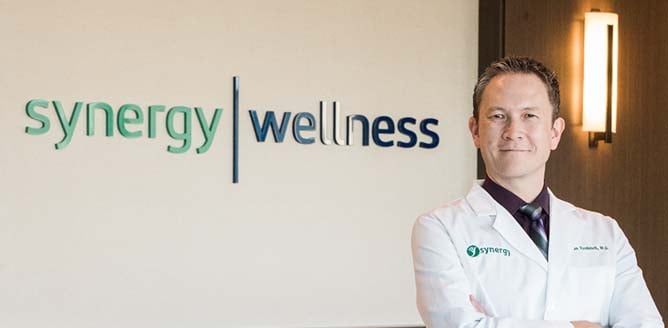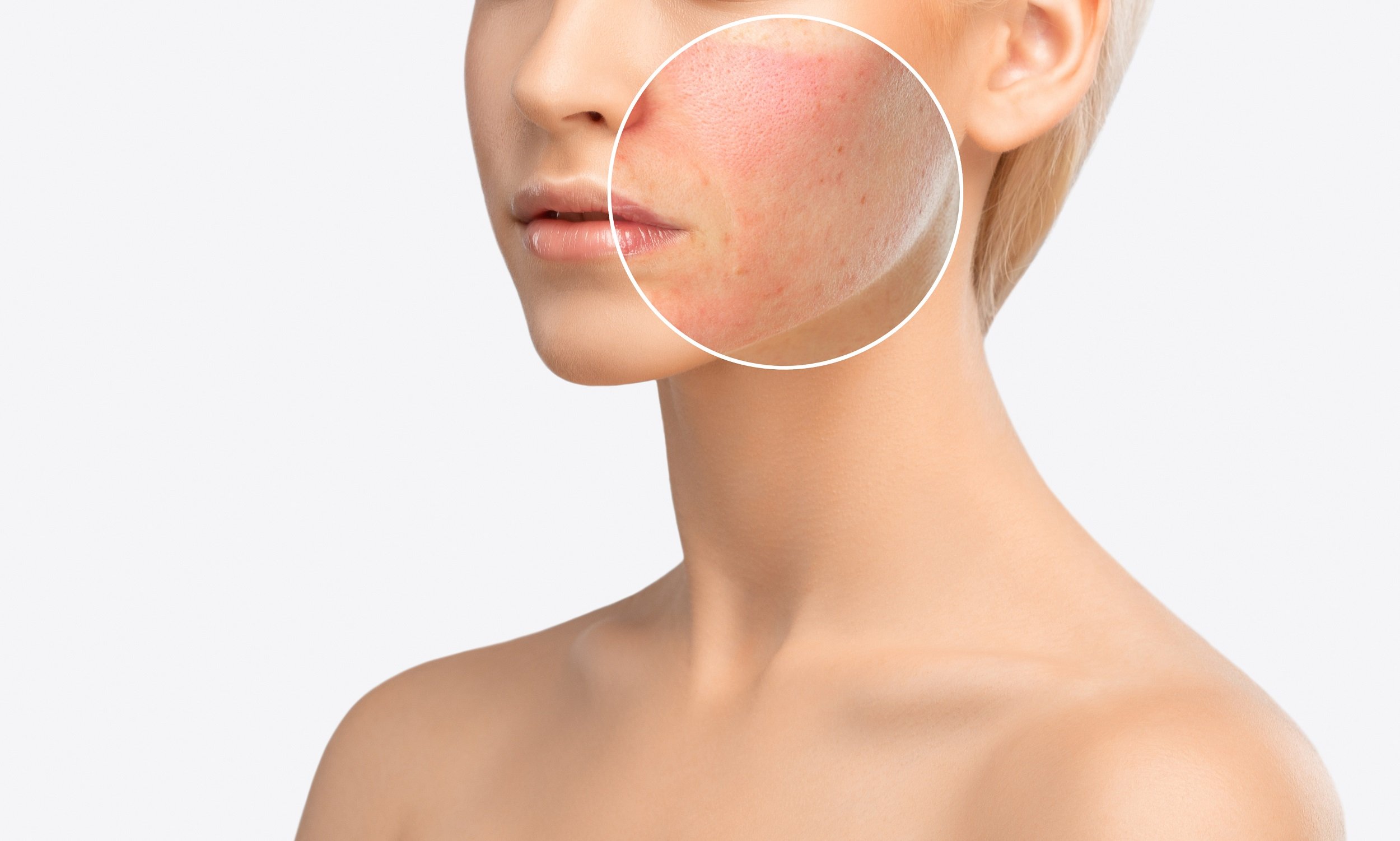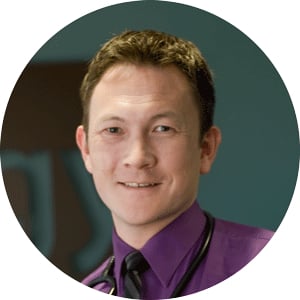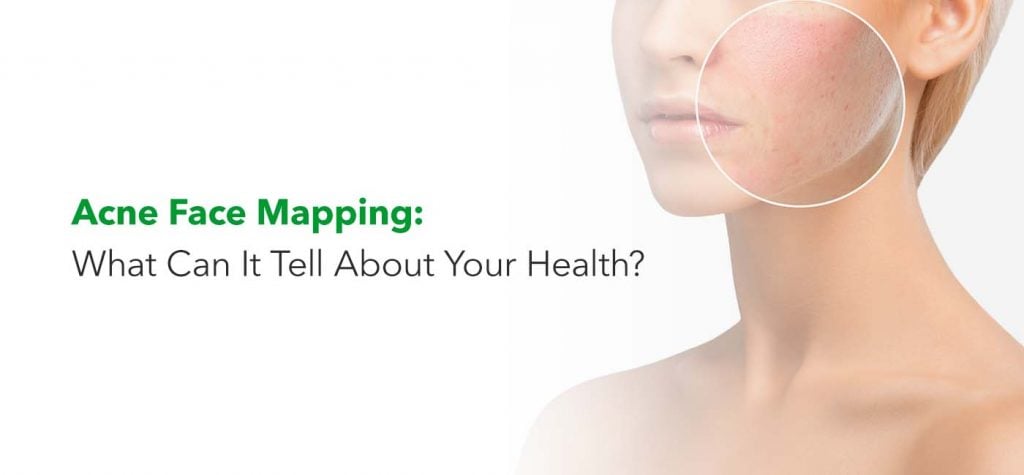
Acne can be like a rain cloud on a sunny day. No one wants to discover a breakout when they look in the mirror, though it happens to just about everyone at some point. According to the American Academy of Dermatology (AAD), acne is the most common skin ailment in the United States, affecting millions of people every year.
If you’re like most people, you’ve experienced acne and know how it feels. But have you ever thought about what causes acne?
Some practitioners believe that acne reflects your internal health and is caused by a deeper issue. According to this belief, a person can use a face mapping technique to pinpoint the cause of acne. Once someone knows the cause, they can determine appropriate treatment and take action.
Let’s explore the meaning of acne location, face mapping and what modern dermatology says about acne.
What Is Face Mapping for Acne and When Did It Begin?
Face mapping, also known as mien shiang, is a traditional Chinese medicine (TCM) technique that traces back 3,000 years. It’s based on the belief that acne and other skin issues reflect an internal health problem. Before doctors could use CT scans and other imaging tools to diagnose a health issue, face mapping was a way to “see” inside a person’s body.
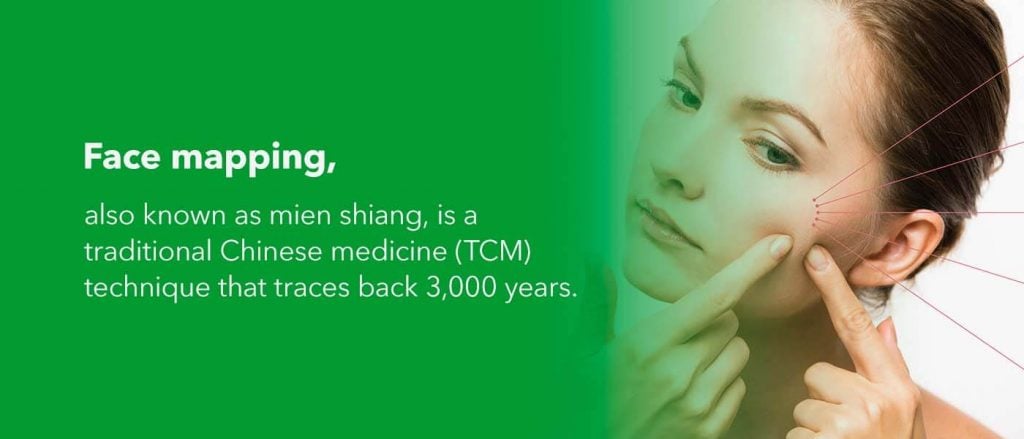
Like many other TCM practices, face mapping incorporates the concept of life force energy, called qi, also known as chi. Chi flows through channels, or meridians, in a person’s body. If this vital energy gets disturbed for any reason, such as by illness, stress or diet, it can show in a person’s face in the form of acne, inflammation or other manifestations.
What Traditional Chinese Medicine Says About Acne
In traditional Chinese medicine, many skin problems point to issues with an internal organ. The acne location helps practitioners determine which organ is affected by disrupted chi. For example, using an acne face map, a TCM practitioner might say that a breakout on the forehead points to poor intestinal health. They may then recommend dietary or lifestyle changes to improve gut health and solve the acne problem.
According to TCM acne mapping on the face, here’s what each location means:
- Forehead: The forehead represents the digestive system. A poor diet, stress or intestinal disorders like irritable bowel syndrome may cause forehead acne.
- Eyebrows: The space between the eyebrows corresponds with the liver. Since the liver is responsible for detoxifying the body, blemishes in this area point to toxins from a poor diet or negative emotions.
- Temples: The temples connect to the kidneys and bladder. A kidney or bladder infection or inflammation can cause acne in the temple region. Medication side effects may also show up in these areas as acne.
- Cheeks: The cheeks represent the respiratory system, stomach or spleen. Breakouts in these areas may point to stomach inflammation, sinus problems or allergies.
- Nose: The nose relates to the heart. Oiliness and acne on or around the nose could point to an issue with cholesterol or blood pressure.
- Mouth: The mouth corresponds to the colon and stomach. Acne around the mouth means a person may have a stomach ulcer or eats too much uncooked or cold food. Eating meals cold or raw may cause the stomach to work extra hard to heat the food.
- Chin: The chin and jawline represent the reproductive system and hormones. Acne in these areas might connect to the menstrual cycle or result from stress.
What Dermatology Says About Acne Spots on the Face
Traditional Chinese face mapping is not rooted in science and is instead influenced by Taoist philosophy. Today’s doctors believe the real causes of acne are oil or dead skin cells. When a pore gets clogged with oil or skin cells, a pimple can appear.
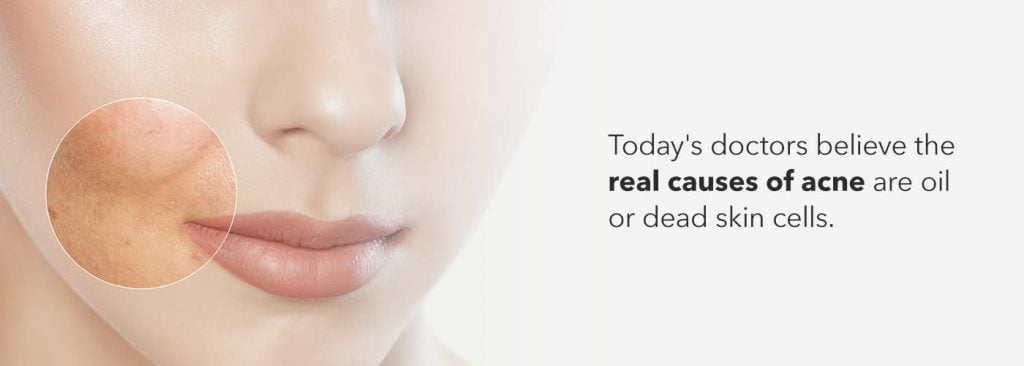
Bacteria can also lead to inflammation and result in skin bumps. You may be surprised to find out that greasy foods and stress can’t cause acne, but they can make it worse.
Does Chinese acne face mapping still have a place in modern science? Despite its lack of scientific evidence, face mapping can offer insight and help you determine factors that contribute to breakouts. Here’s what a modern face map might look like:
- Forehead: You may have heard people referring to the forehead, nose and chin as the T-zone. In general, the T-zone has more oil-producing glands than other parts of the face, which naturally moisturize the skin. This is why breakouts are common in the T-zone. Hair products, such as waxy or oily items, may also clog skin pores and cause breakouts along your hairline.
- Cheeks: Skin in the cheek area can get dry and irritated more easily than other face parts. Since this area has drier skin, it’s more sensitive to friction. Rubbing your cheek on a pillowcase or holding a phone against your face can cause friction and irritation that might lead to acne. Using a dirty phone or pillowcase could also send more bacteria to the skin and worsen acne.
- Chin and jawline: The chin and jawline may be more sensitive to hormonal changes than other areas, potentially leading to breakouts during puberty and before menstruation. For example, according to the Journal of the European Academy of Dermatology and Venereology, several studies have shown that up to 85% of adult women experience worsened acne before their period.
- Nose: Like other parts of the T-zone, your nose is an area of high oil production. Excess oil on or around your nose can clog pores and lead to pimples. The nose is also vulnerable to acne because it typically has larger pores than other parts of the face. Bacteria, dead skin and oil can easily get trapped in pores on or around the nose and cause blackheads or whiteheads.
What Can You Do About Acne?
Acne doesn’t have to keep you from feeling your best, no matter what a face map says about pimples. You can effectively treat clogged pores and prevent a breakout from worsening or forming scars. Here are some tips:
- Wash your face every day: Regularly washing your face helps remove oil and dead skin buildup from your pores. You can use mild soap or a gentle foaming cleanser and warm water for your daily face-washing routine. You’ll also want to use your fingertips to clean your face since washcloths or sponges can cause irritation. The AAD recommends washing your face when you wake up, before going to bed and after sweating.
- Shampoo your hair: Do you tend to have oily hair? If so, try to shampoo your hair every day. Clean hair is less likely to clog pores if it touches your skin.
- Avoid touching your face: Did you know most people touch their face several times an hour? According to a 2015 study, participants touched their faces an average of 23 times an hour. Touching your face frequently throughout the day can add bacteria and pressure to your skin, potentially worsening a breakout. Try to keep your hands busy in other ways, such as playing with a stress ball or rubber band.
- Add a second product to your routine: If you don’t see any improvements after washing your face every day for about a month, try adding a second product to your routine. Choose a treatment that contains an acne-fighting ingredient that your current cleanser does not have. Also, ensure you use ingredients designed to target specific types of acne. For example, if you want to address oiliness and unclog pores, look for retinoids. If you wish to relieve inflammation while unclogging pores, try a product containing salicylic acid.
- Consult with a dermatologist: If over-the-counter products do not help after about three months, or if you experience acne cysts, you may want to meet with a dermatologist. A dermatologist can prescribe medication and develop a custom plan to successfully treat pesky, painful or severe acne.
- Use oil-free cosmetics: Some cosmetics can clog pores and exacerbate acne, so be sure to check makeup ingredients before application. Look for products that are oil-free and non-comedogenic or non-acnegenic, meaning they don’t clog pores. Keep in mind that “safe” cosmetics may still cause acne in some people. You might have to try different products before finding a brand that works for your skin.
- Keep hair products away from skin: When using hair spray, gel, dry shampoo or another product, try to keep it away from your face. Hair products often contain oil which can clog your pores. It’s helpful to use water-based hair products when possible. You might also try washing your face after applying hair products rather than before to rinse away pore-clogging residue.
- Regularly clean your phone and pillowcase: Make sure to periodically clean your pillowcase, phone, sheets, hats and anything else that may touch your face to keep pores free of oil and dirt. Strive to wash your pillowcase at least two times a week, especially if your cheeks are prone to acne. Also, regularly clean your phone with a disinfectant wipe and avoid taking it into the bathroom.
- Wash makeup brushes: Oil and bacteria build up on makeup brushes, so it’s essential to keep these clean. Aim to gently wash makeup brushes with a fragrance-free shampoo once every one or two weeks.
- Eat a low-glycemic diet: High-glycemic foods and beverages are those that raise your blood sugar fast. They include junk foods like french fries and donuts, along with sugary drinks such as soda. When food causes a spike in blood sugar levels, it leads to inflammation and excess oil production, which may worsen acne. Low-glycemic foods, such as fresh vegetables and beans, cause a slower rise in blood sugar and might help prevent breakouts.
Above all, avoid popping acne. It may be tempting to pick or squeeze pimples to clear them as fast as possible, but it’s best to resist the urge. Popping or picking blemishes can release bacteria deeper into the skin, potentially leading to more acne or scarring. Let the pimple heal on its own or schedule an appointment with a dermatologist for treatment.
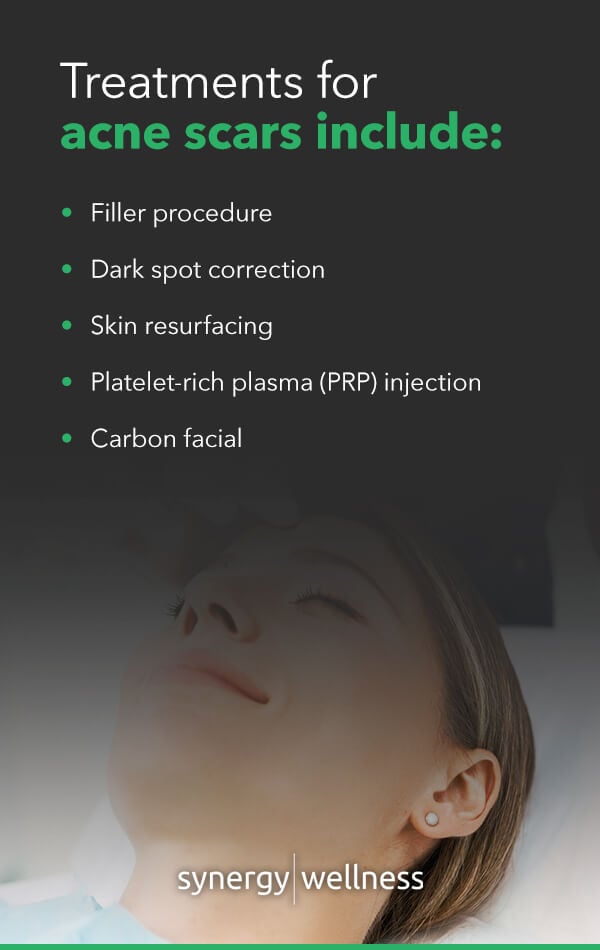
Skin Treatment to Correct Acne Scars
Acne scars are prevalent in people who experience acne. While whiteheads and blackheads usually heal without scarring, some forms of acne, like cysts and nodules, can leave a lasting mark. Acne scars may appear as indentations in the skin or, in some cases, raised marks. The type of scars that form on your skin depends on the unique way your body heals.
Acne scars are treatable regardless of the location or type. The first step to rejuvenating your skin is to meet with a qualified medical aesthetician or dermatologist for an evaluation. These skin care professionals will consider your skin type, goals and needs to help you select the best procedure. Treatments for acne scars include:
- Filler procedure: With a filler procedure, a medical professional injects a substance, called a dermal filler, under the depressed acne scar. The substance then plumps up the skin, filling in the indentation and creating a smooth, even surface. An aesthetician might recommend fillers for any type of depressed scar, though shallower scars may respond best to this treatment.
- Dark spot correction: Acne can sometimes leave red, purple or brown spots on the skin. Although these marks are not scars and will eventually fade on their own, they can be treated quickly and effectively with an in-office procedure. For example, at Synergy Wellness, we can apply an intense pulsed light treatment (IPL) to improve dark spots and redness. IPL may also be used to treat sun damage and vascular lesions.
- Skin resurfacing: A resurfacing procedure removes skin layers, allowing the body to generate new layers of skin. Skin resurfacing may be the recommended treatment for widespread scarring. There are many skin resurfacing procedures, including Morpheus8, an advanced, minimally invasive microneedling treatment. With Morpheus8, your aesthetician will deliver radiofrequency energy to the affected area to facilitate new collagen and elastin production.
- Platelet-rich plasma (PRP) injection: PRP is a substance taken from your blood. It contains unique proteins that help your body grow new cells. To treat acne scars, a trained aesthetician can collect a blood sample and isolate the plasma for the procedure. They’ll then create microchannels on your skin, similar to a microneedling process, and massage the healing PRP into the affected area. The rejuvenating procedure is also called a Vampire Facial.
- Carbon facial: A carbon facial is a gentle, safe and effective treatment used to reduce the appearance of new acne scars. An aesthetician will apply liquid carbon to your skin during a carbon facial and pass a laser across the surface, causing the carbon particles to heat up and stimulate cell growth. The result is a smoother, refreshed look.
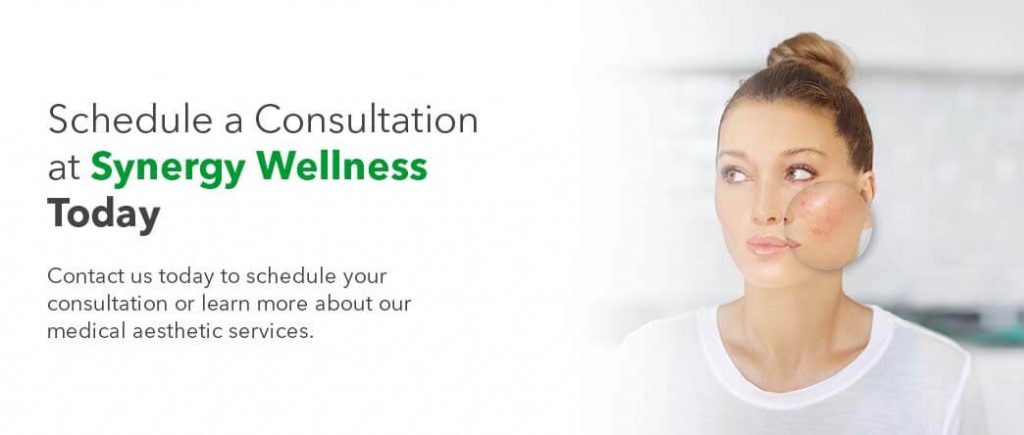
Schedule a Consultation Today
Are you ready to treat acne scars and achieve silky, radiant skin? At Synergy Wellness in Bakersfield, California, our team of beauty experts can help you reach your aesthetic goals while ensuring you feel relaxed and pampered. Contact us today to schedule your consultation or learn more about our medical aesthetic services.

